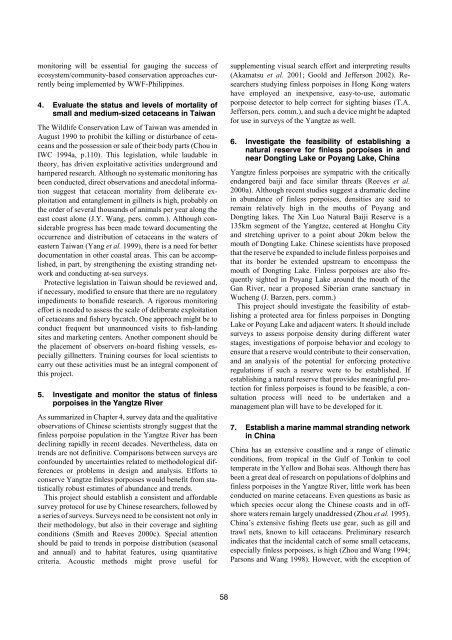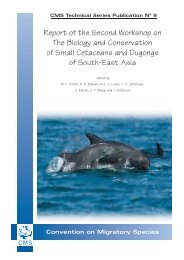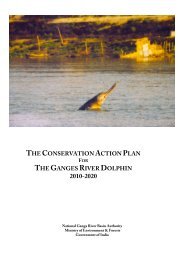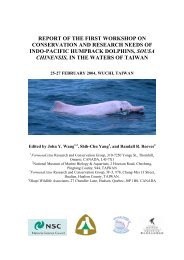Dolphins, Whales and Porpoises: 2002-2010 Conservation - IUCN
Dolphins, Whales and Porpoises: 2002-2010 Conservation - IUCN
Dolphins, Whales and Porpoises: 2002-2010 Conservation - IUCN
You also want an ePaper? Increase the reach of your titles
YUMPU automatically turns print PDFs into web optimized ePapers that Google loves.
monitoring will be essential for gauging the success of<br />
ecosystem/community-based conservation approaches currently<br />
being implemented by WWF-Philippines.<br />
4. Evaluate the status <strong>and</strong> levels of mortality of<br />
small <strong>and</strong> medium-sized cetaceans in Taiwan<br />
The Wildlife <strong>Conservation</strong> Law of Taiwan was amended in<br />
August 1990 to prohibit the killing or disturbance of cetaceans<br />
<strong>and</strong> the possession or sale of their body parts (Chou in<br />
IWC 1994a, p.110). This legislation, while laudable in<br />
theory, has driven exploitative activities underground <strong>and</strong><br />
hampered research. Although no systematic monitoring has<br />
been conducted, direct observations <strong>and</strong> anecdotal information<br />
suggest that cetacean mortality from deliberate exploitation<br />
<strong>and</strong> entanglement in gillnets is high, probably on<br />
the order of several thous<strong>and</strong>s of animals per year along the<br />
east coast alone (J.Y. Wang, pers. comm.). Although considerable<br />
progress has been made toward documenting the<br />
occurrence <strong>and</strong> distribution of cetaceans in the waters of<br />
eastern Taiwan (Yang et al. 1999), there is a need for better<br />
documentation in other coastal areas. This can be accomplished,<br />
in part, by strengthening the existing str<strong>and</strong>ing network<br />
<strong>and</strong> conducting at-sea surveys.<br />
Protective legislation in Taiwan should be reviewed <strong>and</strong>,<br />
if necessary, modified to ensure that there are no regulatory<br />
impediments to bonafide research. A rigorous monitoring<br />
effort is needed to assess the scale of deliberate exploitation<br />
of cetaceans <strong>and</strong> fishery bycatch. One approach might be to<br />
conduct frequent but unannounced visits to fish-l<strong>and</strong>ing<br />
sites <strong>and</strong> marketing centers. Another component should be<br />
the placement of observers on-board fishing vessels, especially<br />
gillnetters. Training courses for local scientists to<br />
carry out these activities must be an integral component of<br />
this project.<br />
5. Investigate <strong>and</strong> monitor the status of finless<br />
porpoises in the Yangtze River<br />
As summarized in Chapter 4, survey data <strong>and</strong> the qualitative<br />
observations of Chinese scientists strongly suggest that the<br />
finless porpoise population in the Yangtze River has been<br />
declining rapidly in recent decades. Nevertheless, data on<br />
trends are not definitive. Comparisons between surveys are<br />
confounded by uncertainties related to methodological differences<br />
or problems in design <strong>and</strong> analysis. Efforts to<br />
conserve Yangtze finless porpoises would benefit from statistically<br />
robust estimates of abundance <strong>and</strong> trends.<br />
This project should establish a consistent <strong>and</strong> affordable<br />
survey protocol for use by Chinese researchers, followed by<br />
a series of surveys. Surveys need to be consistent not only in<br />
their methodology, but also in their coverage <strong>and</strong> sighting<br />
conditions (Smith <strong>and</strong> Reeves 2000c). Special attention<br />
should be paid to trends in porpoise distribution (seasonal<br />
<strong>and</strong> annual) <strong>and</strong> to habitat features, using quantitative<br />
criteria. Acoustic methods might prove useful for<br />
supplementing visual search effort <strong>and</strong> interpreting results<br />
(Akamatsu et al. 2001; Goold <strong>and</strong> Jefferson <strong>2002</strong>). Researchers<br />
studying finless porpoises in Hong Kong waters<br />
have employed an inexpensive, easy-to-use, automatic<br />
porpoise detector to help correct for sighting biases (T.A.<br />
Jefferson, pers. comm.), <strong>and</strong> such a device might be adapted<br />
for use in surveys of the Yangtze as well.<br />
6. Investigate the feasibility of establishing a<br />
natural reserve for finless porpoises in <strong>and</strong><br />
near Dongting Lake or Poyang Lake, China<br />
Yangtze finless porpoises are sympatric with the critically<br />
endangered baiji <strong>and</strong> face similar threats (Reeves et al.<br />
2000a). Although recent studies suggest a dramatic decline<br />
in abundance of finless porpoises, densities are said to<br />
remain relatively high in the mouths of Poyang <strong>and</strong><br />
Dongting lakes. The Xin Luo Natural Baiji Reserve is a<br />
135km segment of the Yangtze, centered at Honghu City<br />
<strong>and</strong> stretching upriver to a point about 20km below the<br />
mouth of Dongting Lake. Chinese scientists have proposed<br />
that the reserve be exp<strong>and</strong>ed to include finless porpoises <strong>and</strong><br />
that its border be extended upstream to encompass the<br />
mouth of Dongting Lake. Finless porpoises are also frequently<br />
sighted in Poyang Lake around the mouth of the<br />
Gan River, near a proposed Siberian crane sanctuary in<br />
Wucheng (J. Barzen, pers. comm.)<br />
This project should investigate the feasibility of establishing<br />
a protected area for finless porpoises in Dongting<br />
Lake or Poyang Lake <strong>and</strong> adjacent waters. It should include<br />
surveys to assess porpoise density during different water<br />
stages, investigations of porpoise behavior <strong>and</strong> ecology to<br />
ensure that a reserve would contribute to their conservation,<br />
<strong>and</strong> an analysis of the potential for enforcing protective<br />
regulations if such a reserve were to be established. If<br />
establishing a natural reserve that provides meaningful protection<br />
for finless porpoises is found to be feasible, a consultation<br />
process will need to be undertaken <strong>and</strong> a<br />
management plan will have to be developed for it.<br />
7. Establish a marine mammal str<strong>and</strong>ing network<br />
in China<br />
China has an extensive coastline <strong>and</strong> a range of climatic<br />
conditions, from tropical in the Gulf of Tonkin to cool<br />
temperate in the Yellow <strong>and</strong> Bohai seas. Although there has<br />
been a great deal of research on populations of dolphins <strong>and</strong><br />
finless porpoises in the Yangtze River, little work has been<br />
conducted on marine cetaceans. Even questions as basic as<br />
which species occur along the Chinese coasts <strong>and</strong> in offshore<br />
waters remain largely unaddressed (Zhou et al. 1995).<br />
China’s extensive fishing fleets use gear, such as gill <strong>and</strong><br />
trawl nets, known to kill cetaceans. Preliminary research<br />
indicates that the incidental catch of some small cetaceans,<br />
especially finless porpoises, is high (Zhou <strong>and</strong> Wang 1994;<br />
Parsons <strong>and</strong> Wang 1998). However, with the exception of<br />
58





